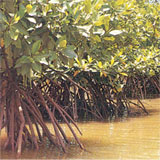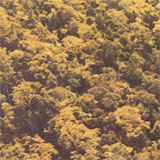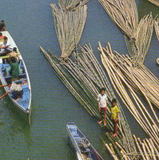
| Community Forestry [back to community agroforestry] |
| forest typology | case studies | forms | design objectives | sources |

Forest Typology |
|
| mangroves | |
“Mangroves do not ‘build’ land but they do have a vital role in colonizing emerging mud banks, consolidating sediments and thereby accelerating the process of land extension.” -The Ecology of Sumatra These forests are very important to erosion control. Mangrove trees take root in the highly salinized tidal zones, where they help to catch and slow sediment and water movement at the coastline. They have been identified as valuable resources in the redevelopment of Aceh’s coastlines. These evergreen coastal forests are known for their high productivity, diversity, and prove to be a valuable habitat for a variety of organisms. Mangrove Forests are rapidly declining in order to clear out coastlines in support of aquaculture, such as shrimp and prawn farming. |
 |
| peatswamp forests |
These deep layers of peat can often found near the east coast behind mangroves. Plants which grow on this type of peat receive no nutrients from the soil itself and is also very acidic. As mangrove forests colonize seawards, other plant communities begin to develop in its wake (peatswamp forests). Since the tides no longer inundate these areas, microorganisms that usually inhabit these areas often die off due to high saline and sulfide soil conditions, and as a result, a thick, undecomposed layer of organic matter accumulates over the mangrove’s clay soil. Peatswamp forests are characterized by its high acidity, low nutrient quality, and low rate of litter input. However, this results in plants that are high in defense compounds such as latex, resins, tannins, and other essential oils. |

| freshwater-swamp forests |
Grow on soils of occasional inundation of mineral-rich freshwater, as well as above and at water level fluctuates where there are periodic drying due to the back up of water during high tides. Riverine and rainwater are its primary sources of water. The high mineral content from freshwater sources has great agricultural advantages, and have suffered considerable destruction and clearing for agricultural purposes. Unlike Peat-Swamp forests, these freshwater-swamp forests lack the deep peat layers that cause low nutrient levels and high flammability. Trees in freshwater swamp-forests must endure prolonged periods of flooding. |
| lowland (tropical) forests |
Lowland forests are the most diverse and complex ecosystems in Sumatra. The diversity of tree species in Sumatra’s Lowland Forests is very high. This high diversity in tree and plant species also correlates with a large number of rare plant species in these forests. These tropical forests are characterized by their high amounts of plant material, and consist of thick climbers, large buttressing trees, and tall, smooth-barked trunks. However, ecological understanding of these forest systems are minimal study of these forests since a majority of these forests are grown as profitable timber stands. |
 |
| bamboo forests |
Bamboo Forests are not directly accessible in Banda Aceh and its surrounding province. However, these forests are in abundance in the southern end of the Sumatra, and has the potential to be a valuable natural resource in this area.
Bamboo can grow in a variety of environments, and is especially important in rural development. Bamboo forests can be found in natural forests, plantation forests, and in community forest areas in many Indonesia villages. It can grow in both wet and dry conditions, and species diversity is strongly correlated by its altitude, with greater species diversity at higher altitudes. It is one of the useful plants in the regions, bamboo produces a wide range of products that have contributed to both social and economic gains in Indonesia. Bamboo is a fast growing plant and can be propagated quite easily. |
 |
| [Back to top] |